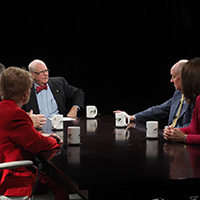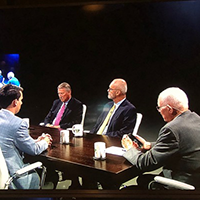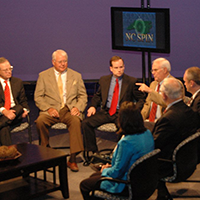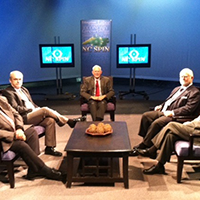Election data shows widening of NC's urban-rual divide
Published December 16, 2016
by Michael Bitzer, Political Science Professor, Catawba College, wfae.org, December 12, 2016.
Now that the dust has finally settled on North Carolina’s elections, some preliminary analyses can be conducted on the voting patterns in the state, which experienced a 2-to-1 split in the big three statewide contests between the two parties.
With Republicans claiming the U.S. presidential and U.S. senate contests, and the Democrats claiming the governor’s, it would appear that the era of split ticket voters has returned to the state.
We’ve been here before. In 2000, Republican presidential nominee George W. Bush won North Carolina, while Democrat Mike Easley won the governor’s race. However, the 2016 election may be less of partisan ticket-bouncing and more likely a continuing redistribution of regionalism within the state.
In comparing 2012’s to 2016’s election results in urban, suburban, and rural counties, the regional vote totals (with the percentages in each region above the column) shows a deepening of the partisan divide.
Democrats widened the spread in urban areas (from a 12-point margin of victory to 15 points), while suburban and rural counties became more Republican in their vote margins (from a 24-point spread in 2012 to a nearly 2-to-1 margin in suburban areas, and rural areas expanding to a 22-point margin from a 14-point margin in 2012).
In this comparison, Donald Trump lost votes in urban areas compared to Mitt Romney’s performance (down 31,000), while adding to Romney’s performance in both suburban (up 65,000) and rural (up 58,000) counties. Conversely, Hillary Clinton added to Barak Obama’s urban votes (up 68,000), while slipping in suburban counties (down 11,000) and dropping in rural counties (down 45,000).
Using the presidential election as a baseline analysis, the divide between urban versus suburban and rural North Carolina appears to be deepening. Of course, this could be truly based on the candidates themselves, their campaign strategies, and a host of other factors. But in looking at the most fundamental election contest that attracts the highest attention and interest by the voters, the division between urban counties and the rest of the state is widening.
While the U.S. Senate race is harder to compare (the Tillis-Hagan race was a mid-term year), the gubernatorial race this year demonstrates not just what may have been the undoing of the sitting governor in his bid for re-election, but a clear distinction on how regionalism is playing out in a key statewide contest.
In his decisive win in 2012, Pat McCrory claimed 55 percent of the vote, at the upper-end of what most political scientists would describe as a competitive election. This year, with only a little over 10,000 votes out of 4.7 million cast separating McCrory and challenger Roy Cooper, vote patterns in different regions of the state demonstrate a telling shift in the gubernatorial contest from four years ago.
In urban counties, McCrory tied with Walter Dalton, the Democratic gubernatorial candidate, four years ago. At the same time, Barak Obama beat Mitt Romney in urban counties 56 to 44 percent.
This year, McCrory’s urban votes plunged, by over 160,000, with Mecklenburg County contributing nearly 60,000 fewer votes to the former Charlotte mayor than he received in 2012’s contest. This year, the margin-of-victory percentage ballooned to a 58-40 spread in urban counties.
While the incumbent governor held his own in rural counties, McCrory not only suffered in urban counties, but also in suburban counties. In 2012’s contest, he bested the Democratic challenger with a 36-point margin of victory (67 to 31 percent) in suburban counties. This year, while McCrory’s vote totals were slightly off in suburban counties (about 5,000), Cooper expanded the Democrat’s suburban gubernatorial vote by over 76,000 votes, and shrunk the margin of victory in those counties for McCrory to a 15-point difference (61-36 percent).
Much more will be analyzed about this election, especially when the state board of elections releases the voter data file of who showed up to cast ballots, but this preliminary look at the state’s dynamics seems to indicate the urban-versus-everyone else in North Carolina continues to widen.
http://wfae.org/post/election-data-shows-widening-ncs-urban-vs-rural-divide
December 16, 2016 at 8:38 pm
Pat Kelley says:
Please use this edited version of my reply - thanks: "Governor McCrory of North Carolina never achieved the success of Mayor McCrory of Charlotte. My spouse and I voted for him in 2012, but time after time we would just shake our heads when his decisions disappointed us, and it wasn't just muttering "what is he thinking?" after the HB2 debacle and his eventual doubling down. To us unaffiliated voters, his stance on the coal ash mess was just as alarming as it made us think of the poor folks in Flint. Sadly, our state has witnessed 16 years of weak governorship, and the Republicans certainly haven't helped the incoming guy's chances either. Politicians on both sides of the aisle ask for our support and then get into power struggles of ego and arrogance rather than working together to make our state great again. Right now North Carolina is an embarrassment throughout the world, yet I trust the next generation of office seekers will act more professionally when these old dudes and dames exit the political picture. I think that is our only hope."









